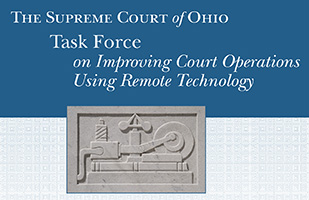I-Court Report Envisions an Innovative Future

A task force to study Ohio courts’ use of technology during COVID has released its report with recommendations.

A task force to study Ohio courts’ use of technology during COVID has released its report with recommendations.
A task force created to study how Ohio courts have used technology during COVID and how innovation will continue in the future has released its report with recommendations.
Ohio Supreme Court Chief Justice Maureen O’Connor announced the Improving Court Operations Using Remote Technology (iCOURT) Task Force’s creation last September. The goal was to review how courts were using technology during the pandemic and to issue recommendations for the post-pandemic era to increase efficiency and access to justice.
“I’m so proud of this task force and their extensive research and compilation of data,” Chief Justice O’Connor said.
“The use of remote technology was a game changer in assuring that Ohio courts remained open for business during the pandemic,” she said. “Now that we have these recommendations we can look forward to a transformation in the way justice is administered in Ohio.”
A rapid boost in technology at the local court level in Ohio came soon after the COVID-19 pandemic struck when Chief Justice O’Connor provided $6 million of the Supreme Court’s budget on an emergency basis in spring 2020. The chief justice followed with another $8.65 million this year to support technology in the courts during the extraordinary circumstances.
The iCOURT Task Force surveyed judicial officers, court personnel, attorneys, litigants, and justice system partners to garner the perspectives of all participants in the justice system. They were queried about the types of technology they employed to conduct remote hearings and deliver court services.
The task force identified access to reliable internet service and equipment as ongoing challenges. The technology benefits cited by local courts, attorneys, and litigants included financial savings, decreased failure-to-appear rates, and increased engagement with court participants.
The task force also researched courts around the country to identify best practices.
The iCOURT Task Force was chaired by Highland County Common Pleas Judge Rocky Coss.
“I believe that the implementation of the task force recommendations will modernize court operations, allow courts to fully utilize the efficiencies that modern technology solutions offer, increase methods of access to the courts by participants, and increase transparency of the courts’ proceedings,” Judge Coss said.
The task force report contains recommendations that comprehensively address the courts’ operational responsibilities, the administration of justice inside the courtroom, and clerk of court functions.
The report recommends changes to the various court rules of procedure and the Ohio Revised Code. These changes include creating minimum standards to form a framework for the continued use of technology, and best-practice ideas collected from courts within Ohio and around the country.
“The report does not recommend that all courts be mandated to utilize technology and to conduct remote hearings, but rather that courts and judges have the discretion to do so when appropriate,” Judge Coss said.
Recommendations for the Ohio Supreme Court include:
- Work to develop “minimum standards for technology use” for local courts
- Amend the Rules of Superintendence to have courts adopt a local plan on technology
- Provide education for local IT court staff by the Judicial College of Ohio
- Enhance the features of the Ohio Courts Network to become broader and more user-friendly.
Recommendations for the local courts include:
- Use SMS/text messaging/email to provide gentle reminders about court appearances and thus reduce failure-to-appear rates
- Develop a mobile application where parties can access case information, make a payment, and electronically upload and sign documents
- Provide virtual assistants or kiosks to help users perform court-related functions
- Develop a procedure for parties to request a remote proceeding
- Adopt procedures to allow livestreaming of court hearings and participation in the Ohio Virtual Courtroom Directory.
Courts are encouraged to take advantage of the efficiencies they have experienced over past 17 months and move forward with implementing the recommendations. The steps can enhance their ability to administer justice efficiently and effectively.


